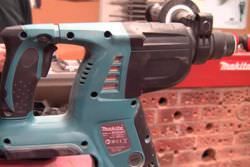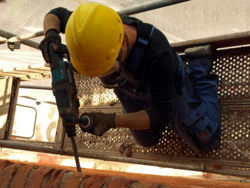Of all the tools made specifically for boring holes, there are only two when it comes to drilling a screw into concrete — a hammer drill and a rotary hammer . The hammer drill is an enhanced version of the standard drill, and is usually used on relatively softer material like light-duty concrete or masonry, or where drilling only requires holes up to 3/8” diameter. The rotary hammer has a rotary part to move the hammer in a more circular motion, resulting in a more powerful drill or bore of larger holes into a masonry or concrete surface. This is the tool you want to drill through harder concrete, or for a hole larger than 1/2-inch.
<iframe width=”450″ height=”338″ frameborder=”0″ allowfullscreen src=”https://www.youtube.com/embed/6UMY4lkcCqE?iv_load_policy=3&rel=0″></iframe>
Contents
Comparison chart
| Hammer Drill | Rotary Hammer | |
|---|---|---|
| Function | Light-duty concrete or masonry drilling for holes up to 3/8” diameter | Harder concrete or for larger holes; preferred for its strength and shock-absorbing qualities |
| Used by | Handymen who do occasional odd jobs , Amateurs, DIY homeowners. | Construction sites, professional construction and concrete workers. |
| Material used to drill | Soft concrete, masonry or brick | Hard concrete |
| Drill holes | 3/16″ to 7/8″ in diameter | 1/4″ to 2″ in diameter |
| Mechanism | Rapid back and forth action of rotate-and-hammer while drilling; bores into concrete without burning the bit. | Same “rotate-and-hammer” as hammer drills, but with a piston mechanism for more powerful hammer action. |
| Weight | 4 to 8 pounds | At 14 to 18 pounds, a rotary hammer is much heavier, larger, buklier, but is surprisingly easy on the hands because of it’s mechanism. |
Mechanism and Impact
Both a hammer drill and rotary hammer pound its bit while spinning and pulverizing concrete, but the pounding mechanism works differently in the two tools.
A hammer drill is quite similar to a drill a typical non–professional or DIY homeowner might own, and features mechanisms that drive drill bits forward as it rotates, resulting in a high-speed pulsing hammer-like action. The power of a hammer drill is generated by rotating ribbed clutch plates, and impact happens as the two ribbed metal discs click in and out against each other. The hammer added to the drill takes the same straight-shank bits as a regular drill. The generated torque from drilling concrete may cause bits to slip in the chuck. This type of hammering is useful for projects that have use for drilling into brick, block, concrete or other masonry surfaces. The harness speeds of a hammer drill are much higher compared to that of an ordinary corded drill, making it useful for non-ordinary applications.

Hammer drill

Hammer drill drilling through brick
A rotary hammer uses a more piston hammering-type action — a cylinder of air is compressed by a piston in a rotary hammer, which results in beating the bit. Because of this action, the rotary hammer not only generates more power , it is also much easier on the hands in spite of being heavier, larger, and bulkier. Because of this mechanism, rotary hammers ease through harder material jobs like concrete or strong masonry.

Rotary hammer

Rotary hammer drilling through hard concrete
How to Use
This video demonstrates the use of a hammer drill on a concrete brick:
<iframe width=”450″ height=”338″ frameborder=”0″ allowfullscreen src=”https://www.youtube.com/embed/NjE6nsfdjpo?iv_load_policy=3&rel=0″></iframe>
A similar video on how to use a rotary hammer:
<iframe width=”640″ height=”360″ frameborder=”0″ allowfullscreen src=”https://www.youtube.com/embed/eUqlJHkpzZI?iv_load_policy=3&rel=0&start=17″></iframe>
Choice of Tools
The chuck/drive system is a key component of these power drilling tools. Some system examples are “SDS”, “SDS Plus”, “SDS Max”, and “spline”. SDS, which in German is ‘Steck – Dreh – Sitz’ (translated ‘Insert – Twist – Stay’), was developed by Bosch in 1975 for hammer drills. SDS uses a cylindrical shank on the bit, with indents held by the chuck. SDS/SDS-Plus is a 10 mm shank with 2-4 open grooves held by the driving wedges, and two closed grooves held by locking balls. SDS-Max has an 18 mm shank with three open grooves and locking segments rather than balls. It is designed for hammers over 11lbs (5 kg). Spline drives are not as common in the marketplace, with a design of the spline drive providing more surface-grab for high-torque use.
Cost
A Bosch 11236VS 7.5 Amp 1-1/8-Inch SDS Rotary Hammer, and like drills, are priced from $165 to over $300.
The Bosch 1194AVSRK 8 Amp 1/2-Inch Hammer Drill, and similar used products, can be purchased with prices ranging from near $100 to $200.
Where to Buy
There are some great options in corded and cordless power rotary hammers at Amazon’s Best Sellers list for rotary hammers
A similar set of numerous options for hammer drills can be found on the Amazon’s Best Sellers list for power hammer drills
References
- Who Needs a Hammer Drill – popularmechanics.com
- Hammer Drill vs. Rotary Hammer: Tool Test – popularmechanics.com
- Rotary Hammer and Hammer Drill diychatroom.com
- Rotary Hammer or Hammer Drill – doityourself.com
- Bosch 1194AVSRK 8 Amp 1/2-Inch Hammer Drill
- Bosch 11236VS 7.5 Amp 1-1/8-Inch SDS Rotary Hammer
